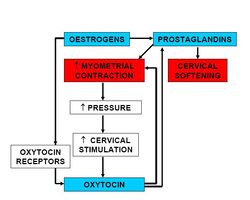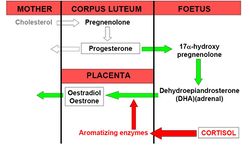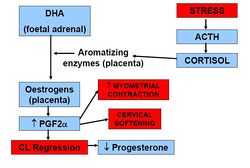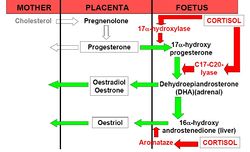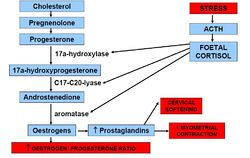Difference between revisions of "Parturition Endocrine Control - Anatomy & Physiology"
| (One intermediate revision by the same user not shown) | |||
| Line 1: | Line 1: | ||
| − | |||
== Introduction == | == Introduction == | ||
| Line 15: | Line 14: | ||
Oxytocin acts to increase [[Uterine Contraction - Anatomy & Physiology|myometrial contraction]] (positive feedback) and prostaglandin release. | Oxytocin acts to increase [[Uterine Contraction - Anatomy & Physiology|myometrial contraction]] (positive feedback) and prostaglandin release. | ||
| − | === | + | === Furgesson Reflex === |
| − | The | + | The furgesson reflex is a neuroendocrine reflex. Oxytocin is released in response to cervical stimulation by the foetus, this causes further synthesis and secretion of oxytocin, thus exhibiting positive feedback. Oxytocin concentrations continue to rise until the foetus is expelled, thus the cervical stimulation ceases. |
=== Role of Relaxin === | === Role of Relaxin === | ||
| Line 80: | Line 79: | ||
As previously explained, parturition is dependent on a rise in foetal cortisol. However, in this case, the rise in foetal cortisol leads to a decrease in '''maternal''' progesterone. Foetal cortisol causes upregulation of the enzymes, '''17α hydroxylase, C17-C20-lyase and aromatase''' in order to increase the oestrogen:progesterone ratio. | As previously explained, parturition is dependent on a rise in foetal cortisol. However, in this case, the rise in foetal cortisol leads to a decrease in '''maternal''' progesterone. Foetal cortisol causes upregulation of the enzymes, '''17α hydroxylase, C17-C20-lyase and aromatase''' in order to increase the oestrogen:progesterone ratio. | ||
| − | + | ||
[[Category:Parturition]] | [[Category:Parturition]] | ||
[[Category:Endocrine System - Anatomy & Physiology]] | [[Category:Endocrine System - Anatomy & Physiology]] | ||
[[Category:A&P Done]] | [[Category:A&P Done]] | ||
Revision as of 15:17, 10 January 2011
Introduction
The foetus triggers the onset of parturition, by initiating a cascade of complex endocrine/biochemical events. The foetal hypothalamo-pituitary-adrenal axis is obligatory for the initiation of parturition.
Regulation of Prostaglandins
The uterus is an important site of prostaglandin synthesis. During pregnancy, the presence of the foetus inhibits the production of prostaglandins in order to prevent luteolysis. At parturition, an increase in prostaglandin synthesis is required. Prostaglandins are synthesized from arachadonic acid, which is derived from glycerophospholipids by the enzyme phospholipase A2 (PLA2). Oestrogen liberates phospholipase A2 from lysosomes. Progesterone stabilises lysosomes, so phospholipase A2 cannot be liberated from them. An increase in oestrogen:progesterone ratio increases prostaglandin production. The increase in oestradiol (bioactive oestrogen) also increases expression of endometrial oxytocin receptors.
Regulation of Oxytocin
Details of oxytocin synthesis and secretion may be found in pituitary gland page.
Oxytocin acts to increase myometrial contraction (positive feedback) and prostaglandin release.
Furgesson Reflex
The furgesson reflex is a neuroendocrine reflex. Oxytocin is released in response to cervical stimulation by the foetus, this causes further synthesis and secretion of oxytocin, thus exhibiting positive feedback. Oxytocin concentrations continue to rise until the foetus is expelled, thus the cervical stimulation ceases.
Role of Relaxin
Relaxin is a glycoprotein hormone. It is produced by either the corpus luteum or placenta depending on species. Its synthesis is stimulated by PGF2α. This causes softening of the connective tissue in the cervix and promotes elasticity of the pelvic ligaments, thus preparing the birth canal so that the passage of the foetus can occur with relative ease.
Role of Oestrodiol Elevation prior to Parturition
This elevation initiates the secretory activity of the reproductive tract, particularly the cervix, resulting in the cervix and vagina producing mucus. This washes out the cervical seal of pregnancy and lubricates the cervical canal and vagina to reduce friction, enabling the foetus to exit the reproductive tract with relative ease.
Onset of Parturition
| Species | Ewe | Horse | Queen | Goat | Sow | Cow |
|---|---|---|---|---|---|---|
| % of pregnancy when the Corpus Luteum is the principle source of Progesterone | 37 | 61 | 79 | 100 | 100 | 100 |
| % of pregnancy when the Placenta is the principle source of Progesterone | 63 | 39 | 21 | 0 | 0 | 0 |
Species that depend on the Corpus Luteum
The goat, cow, sow and bitch depend on the corpus luteum.
The foetus initiates parturition. For parturition to occur, progesterone production by the corpus luteum must be terminated. As the foetus grows in a restrictive environment, it becomes stressed. Stress leads to a rise in foetal ACTH. The rise in ACTH causes production of cortisol from the foetal adrenal glands. The rise in foetal cortisol leads to an increased oestrogen:progesterone ratio by upregulating aromatase enzymes, which convert androgens to oestrogens. Cortisol also reduces progesterone production.
Species that depend on Placental Progesterone
In late pregnancy, the ewe, guinea pig, queen and mare depend on placental progesterone.
As previously explained, parturition is dependent on a rise in foetal cortisol. However, in this case, the rise in foetal cortisol leads to a decrease in maternal progesterone. Foetal cortisol causes upregulation of the enzymes, 17α hydroxylase, C17-C20-lyase and aromatase in order to increase the oestrogen:progesterone ratio.
